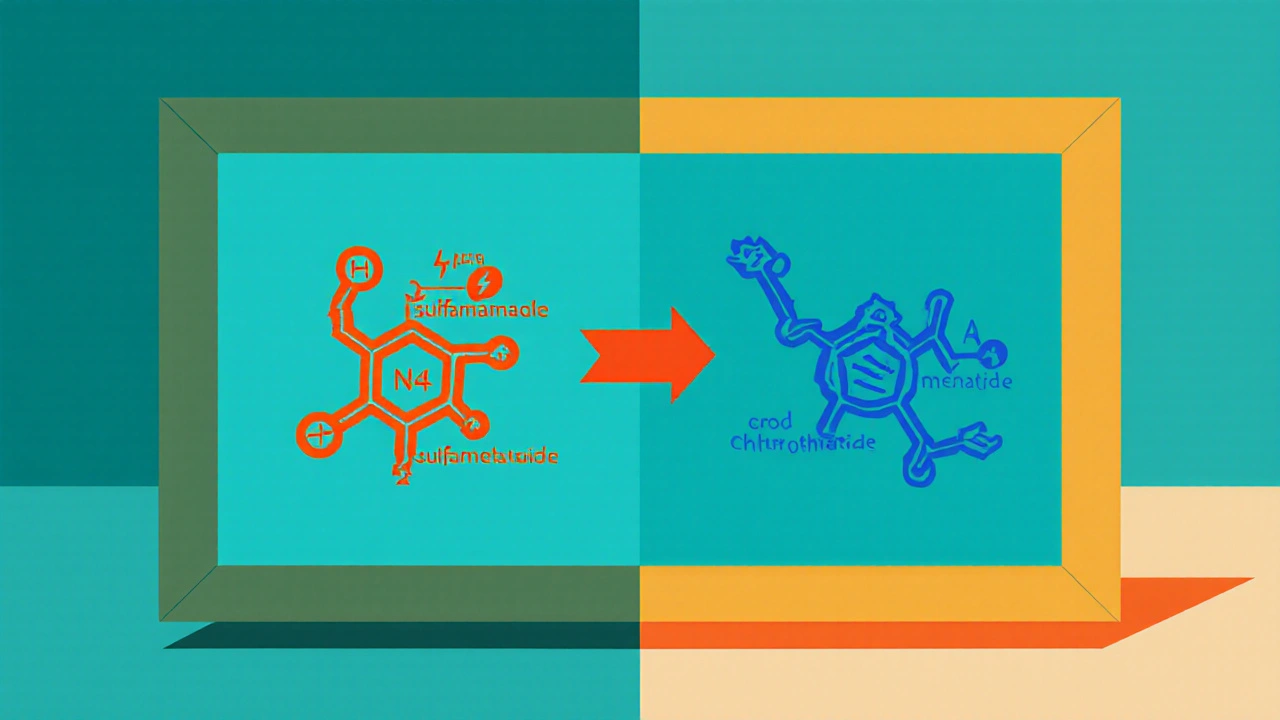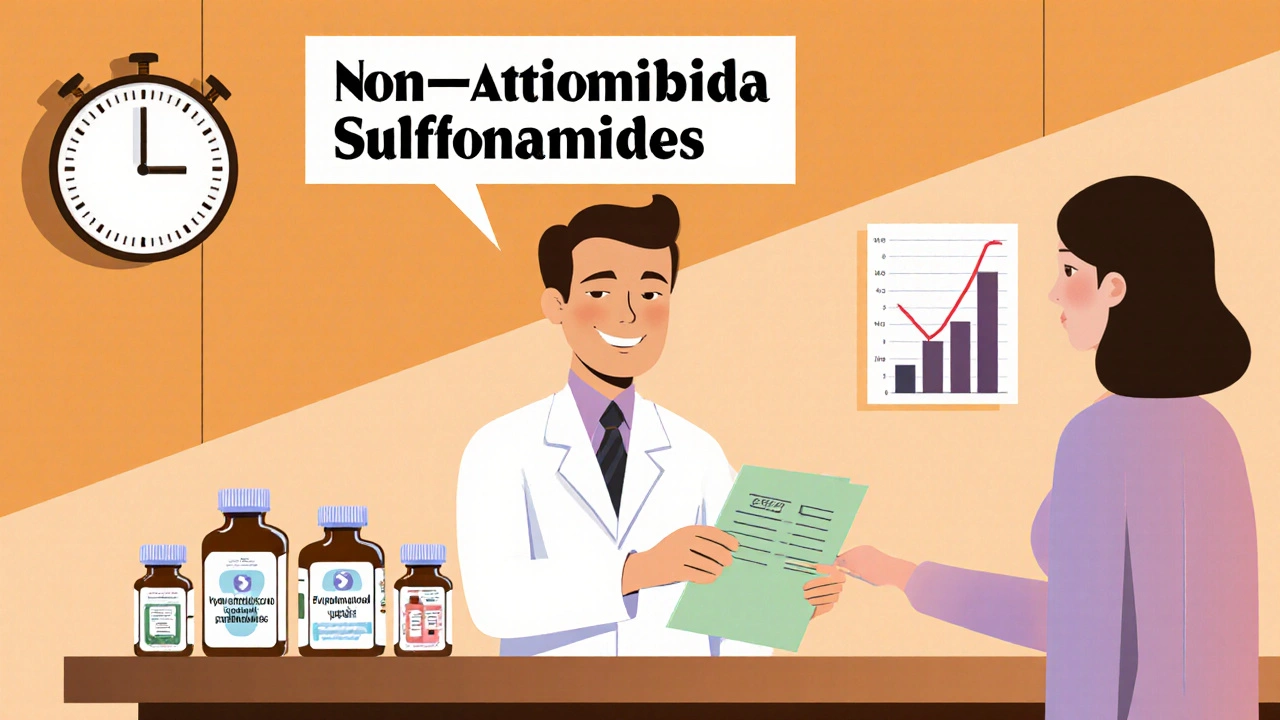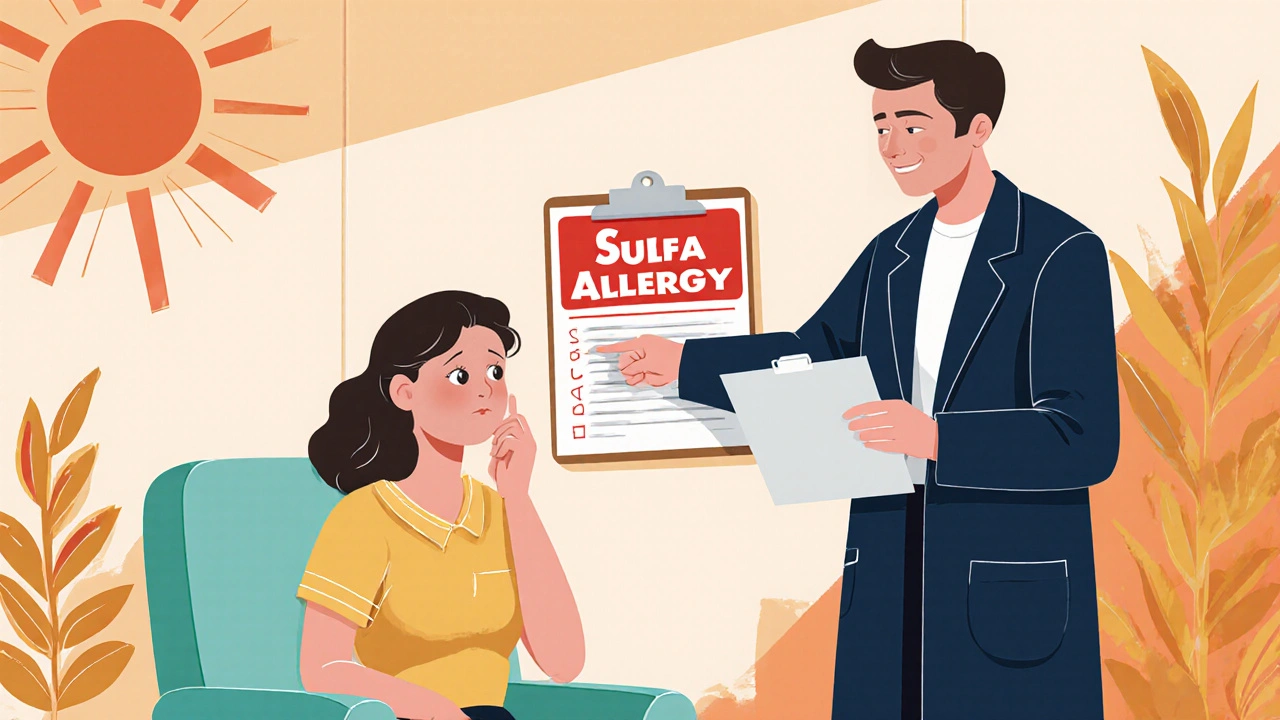Sulfonamide Cross-Reactivity Checker
Check if your drug is safe
This tool identifies whether a sulfonamide drug is an antimicrobial (higher risk) or non-antimicrobial (generally safe) sulfonamide based on structural features.
Ever been told you’re allergic to “sulfa” and then watched doctors dodge basic meds like blood‑pressure pills or eye drops? That label can feel like a brick wall, but the reality is often far less dramatic. Understanding what a sulfonamide allergy truly means-and what it doesn’t-helps you keep that wall from blocking safe, effective treatments.
What a Sulfonamide Allergy Actually Is
When a clinician writes Sulfonamide allergy is a documented immune‑mediated reaction to a drug that contains the sulfonamide functional group (SO₂NH₂). True IgE‑mediated sulfonamide antibiotic allergies occur in roughly 0.3‑0.5% of the general population, according to the 2023 AAAAI Practice Parameter Update. The majority of “sulfa” labels stem from non‑immune side effects, misdiagnosed rashes, or simply a historical note that never got cleared.
How Common Is the Mislabel?
Surveys show 3‑12% of people list a sulfonamide allergy in their records (Lipsky et al., 2022). Yet, only a fraction of those entries represent a genuine IgE‑driven response. This mismatch matters because a 2021 study found patients with a sulfa label receive alternative antibiotics 78.4% of the time, and 32.7% of those alternatives are broader‑spectrum than needed, fueling antimicrobial resistance.
Why the Confusion? Antimicrobial vs. Non‑Antimicrobial Sulfonamides
All sulfonamides share the SO₂NH₂ core, but only antimicrobial sulfonamides carry an aryl‑amine at the N4 position and a nitrogen‑containing heterocycle at N1. Those two structural pieces are the main culprits for the allergic potential.
| Feature | Antimicrobial Sulfonamides | Non‑Antimicrobial Sulfonamides |
|---|---|---|
| Typical Examples | Sulfamethoxazole, Sulfasalazine, Sulfadiazine | Celecoxib, Hydrochlorothiazide, Furosemide, Acetazolamide |
| N4‑Aryl‑amine | Present (key antigenic determinant) | Absent |
| N1 Heterocycle | Often a heterocyclic ring (e.g., pyrimidine) | Simple alkyl or methyl group |
| Metabolic Reactive Intermediates | Forms nitroso metabolites that bind proteins → neo‑antigens | Metabolized without reactive intermediates |
| Cross‑reactivity Risk | High for other antimicrobial sulfonamides | Very low (≈1%); exception: dapsone |
Real‑World Cross‑Reactivity Data
Systematic reviews consistently show a 96‑98% negative predictive value when predicting non‑antimicrobial reactions in patients with a documented antimicrobial sulfonamide allergy. For instance, a 2022 Annals of Allergy review reported a 1.1% reaction rate to hydrochlorothiazide versus 0.9% in controls-statistically insignificant. However, dapsone remains a cautionary outlier, with a 13.2% reaction rate in the same population (Hepner et al., 2019).

Which Non‑Antimicrobial Sulfonamides Are Generally Safe?
- Celecoxib - a COX‑2 inhibitor used for arthritis; lacks N4‑aryl‑amine.
- Hydrochlorothiazide - a thiazide diuretic for hypertension; safe for most sulfa‑labeled patients.
- Furosemide - loop diuretic; structurally distinct, very low cross‑reactivity.
- Acetazolamide - carbonic anhydrase inhibitor for glaucoma; no N4 aryl‑amine.
- Dapsone - used for PJP prophylaxis; shares a heterocyclic N1 ring, so caution is advised.
How to Evaluate a Sulfonamide Allergy
The AAAAI recommends a tiered approach:
- Risk stratify the reported reaction. Low‑risk reactions (e.g., delayed maculopapular rash >72 hours after drug start) can often be challenged directly in an outpatient setting.
- Skin testing or graded oral challenge. For immediate or severe reactions, refer to an allergist. A 2022 study showed 94.7% of patients tolerated a supervised challenge.
- Document precisely. Record the exact symptom, timing, and drug name rather than a vague “sulfa allergy.” This practice reduced inappropriate avoidance by 63% in a 2021 JACI study.
New tools like the SULF‑RISK score - a validated risk‑stratification algorithm - predict true allergy with 92.4% sensitivity and 87.6% specificity.
Practical Steps for Clinicians and Patients
- Ask patients to describe the original reaction. Was it a simple rash, fever, or a life‑threatening Stevens‑Johnson syndrome?
- Consider an oral challenge to a non‑antimicrobial sulfonamide if the reaction was low‑risk.
- Update the electronic health record with the clarified label (e.g., “Sulfamethoxazole rash, no cross‑reactivity to hydrochlorothiazide”).
- Educate patients that “sulfa” does not mean they must avoid sulfur, sulfates, or sulfites-these are chemically unrelated.

Why It Matters for Public Health
Mislabeling costs the U.S. health system an estimated $1.2 billion annually in unnecessary antibiotic use and longer hospital stays. Moreover, relying on broader‑spectrum agents raises resistance rates: 8.3% higher E. coli resistance and 12% higher MRSA resistance when sulfa labels steer clinicians away from first‑line sulfonamides.
Electronic decision‑support tools are already making a dent; hospitals that adopted allergy algorithms reported a 54% drop in inappropriate sulfonamide avoidance.
Bottom Line
If you’ve been labeled “sulfa allergic,” don’t assume every drug with a sulfonamide group is off‑limits. Most non‑antimicrobial sulfonamides are safe, and a simple risk‑stratification or supervised challenge can clear the label. Removing the mislabel not only expands your treatment options but also helps curb antibiotic resistance.
Frequently Asked Questions
Can I take over‑the‑counter pain relievers if I have a sulfa allergy?
Most OTC NSAIDs, including ibuprofen and naproxen, do not contain the sulfonamide group. Celecoxib, a prescription COX‑2 inhibitor, is a sulfonamide but is generally safe for sulfa‑labeled patients because it lacks the N4‑aryl‑amine.
Is there any risk with sulfonylurea diabetes drugs?
Sulfonylureas (e.g., glipizide) are not true sulfonamides; they contain a sulfonylurea moiety, not the SO₂NH₂ group. They are considered safe for people with a sulfa allergy.
What about sulfates in cosmetics?
Sulfates are salts of sulfuric acid and have no structural similarity to sulfonamides. A sulfa allergy does not contraindicate shampoos or body washes that list sodium lauryl sulfate.
How is a sulfonamide allergy test performed?
Testing usually starts with a detailed history. For low‑risk cases, a direct oral challenge with a non‑antimicrobial sulfonamide (e.g., a single dose of hydrochlorothiazide) is administered under observation. High‑risk patients may undergo skin prick or intradermal testing with sulfamethoxazole metabolites, followed by a graded challenge if skin testing is negative.
Should I tell every doctor about my sulfa label?
Yes, but also clarify the nature of the reaction. Include the specific drug (e.g., “rash after sulfamethoxazole”) and any testing you’ve had. This helps providers avoid unnecessary avoidance of safe medications.


Write a comment